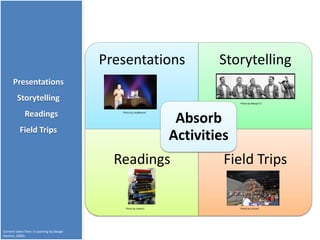Absorb activties
- 1. Presentations Storytelling Presentations Storytelling Photo by Bebop717 Readings Absorb Photo by vividBreeze Field Trips Activities Readings Field Trips Photo by Vaedri1 Photo by rockant Content taken from E-Learning by Design (Horton, 2006).
- 2. šÝšÝßĢshows Photo by JulianBleekr Physical Demonstrations Podcasts Photo by myogaonline Photo by Podcast 70 Presentations Storytelling Types of Readings Presentations Dramas Software Field Trips Rafael De Carvalo Demonstrations Photo by Soren chucker Kuklau Discussion Presentations Informational Films Photo by Stanford Ed Tech Photo by Stitch Content taken from E-Learning by Design (Horton, 2006).
- 3. Demonstrate well-defined Explain and demonstrate procedures Presentations Storytelling Photo by zachstern Photo by myogaonline Readings When to use Field Trips Presentations Provide basic information Model human behaviors Photo by daniel Greene Photo by Malingering Content taken from E-Learning by Design (Horton, 2006).
- 4. Hero Stories Learner Love Stories Stories Presentations Storytelling Readings Many Types of Field Trips moreâĶ Stories Disaster âĒAs you read stories, watch TV and Stories movies, take notes. Discovery Tragedies Stories Content taken from E-Learning by Design (Horton, 2006).
- 5. To demonstrate an application To give concrete examples Presentations Photo by Orbitgal Photo by Julieanne Savage Storytelling Readings When to use Field Trips story-telling To humanize a subject To encourage and motivate and overcome difficulties Photo by unkempt woman Content taken from E-Learning by Design (Horton, 2006).
- 6. Types of reading activities Presentations Individual documents Storytelling Photo by sappymoosetree Readings Field Trips Libraries of documents Photo by cygnoir Predefined Internet resource searches Photo by o6UFE Content taken from E-Learning by Design (Horton, 2006).
- 7. To present complex and difficult For deeper knowledge on a subject information in a stable form for careful study Presentations Storytelling Photo by cdozo Photo by Nataliasha2004 Readings When to use Reading Field Trips Activities No time to develop more Learners are skillful readers and interactive materials motivated to read on their own Photo by Allan Reyes Photo byGuiliagas Content taken from E-Learning by Design (Horton, 2006).
- 8. Types of field trips âĒ Perused in a preset order Presentations âĒ Physically separated examples âĒ Self directed or instructor led Storytelling Photo by Sola427 Readings Guided Tours Field Trips âĒ Learners decide where to go next âĒ Examples collected in one place âĒ Learners compare examples and discover relationships Photo by Dean Terry Museums Content taken from E-Learning by Design (Horton, 2006).
- 9. Photo by ~Last Exit~ Show how concepts taught are applied in the real world Presentations Storytelling Readings Encourage discovery of When to use Provide access to many trends and patterns concrete examples field trips Field Trips Photo by Today is a Good Day Orient leaner's to a new Reveal examples in environment or system context Photo by Dean Terry Content taken from E-Learning by Design (Horton, 2006).
- 10. Guide learners through a procedure Provide an overview before they complete it Presentations Storytelling Photo by Mwesigwa Photo BryneJ Readings When to use Field Trips Guided Tours Know about a product but will not Explore places learners are unable be actually using it to visit Photo by Aj Jasmin Gucci Bear Photo by publicinsomniac Content taken from E-Learning by Design (Horton, 2006).
- 11. Variations of guided tours âĒ Individual experiences of a subject âĒ Take learners to a location to explore Presentations on their own âĒ Watch locations visited by the Storytelling instructor Personal Travel Readings Diaries Field Trips âĒ Explore virtual locales âĒ Visit physical objects you could not tour in reality Tours of Imaginary Worlds Content taken from E-Learning by Design (Horton, 2006).
- 12. Absorb Activities Job Aid Content taken from E-Learning by Design (Horton, 2006).












